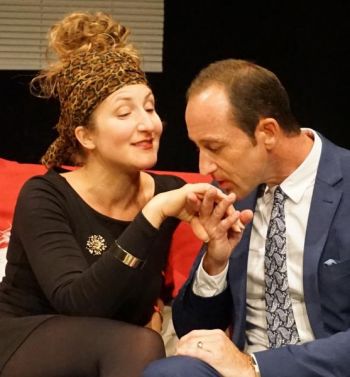Last of the Red Hot Lovers
On a day when Adelaide broke its hottest temperature record, I serendipitously went to the opening night of Neil Simon’s Last of the Red Hot Lovers, presented by Starc Productions. The company philosophy embraces presenting plays where theatre design is secondary and the actor is central. This production captures and highlights both the skill of the actors and the magic of the text.
First produced in 1969, the play transcends time with enduring themes, witty dialogue and servings of human vulnerability. It is also a ‘red hot’ night out. Renowned for celebrating the wit, foibles and culture of his Jewish heritage, in this play, Simon lovingly and gently exploits the stereotypes of the times, right down to the leading man going home to his mother’s apartment to try to organise an illicit liaison.
The original production was written for, and is most commonly performed by, one male and three different female actors. Interestingly, in the STARC production, Director Tony Knight made the decision to give the three female roles to one actor and, rather like Terence Rattigan’s Separate Tables where the two lead actors perform very different roles in the two halves of the play, Knight has cast Marc Clement as Barney for all three of the approximately 30 minute acts, and has given actor Stefanie Rossi a theatrical gift, the challenge of playing three very different women, one in each act. Rossi is a tour-de-force.
 While Barney, Clement’s character, grows and matures across the three acts, Rossi introduces us to smart-mouthed Elaine, a sexpot who likes cigarettes, whiskey, and other women's husbands,Bobbi, an actress he met in the park, who he discovers is a crazy pot smoking chameleon, and Jeannette, his wife's best friend, whose faith in human goodness has reached rock bottom.
While Barney, Clement’s character, grows and matures across the three acts, Rossi introduces us to smart-mouthed Elaine, a sexpot who likes cigarettes, whiskey, and other women's husbands,Bobbi, an actress he met in the park, who he discovers is a crazy pot smoking chameleon, and Jeannette, his wife's best friend, whose faith in human goodness has reached rock bottom.
All of the theatre values in this production are designed to showcase two fine actors. Stephen Dean’s lighting of Barney’s mother’s apartment showcases the era and ensures that the audience at all times can see every action and every subtle and not so subtle nuance that accompanies the lightning-fast, pacey dialogue.
The set is very 1960’s and early 1970’s style, as is the clothing, which is used to evoke that time when the liberation of both men and women from stereotypical roles and behaviours had its flowering. Clever use of the songs of legendary composer Burt Baccarat is used to create a 60’s mood, both for introducing and bridging acts and within the story. You could see the audience humming and smiling and you felt like you were there.
Rossi brings to mind the early work of Barbra Streisand. Her intonation, mastery and use of three subtly different accents, encourages the audience to watch her closely and connect with every word. She postures and struts as Elaine, is both frenetic and languid as Bobbi and is repressed, physically self- contained and inaccessible as Jeanette, looking like a librarian on her lunch hour. Rossi, a trained, skilled and experienced actor flourishes with both the comedy and pathos and is a performer whose versatility is well honed.
 Given Rossi’s confidence and skill, Clement’s Barney could have become a ‘supporting role’, but in fact, whilst hers is the strongest presence, Clement, as Barney creates a man whose confidence, wisdom and charisma grows across the three acts. In Act one he is somewhat gormless and gauche, but his speech in Act three where he defends the decency in people is full of courage, poignancy and human wisdom. We see a man who has grown, reflected and taken stock of his own life; a man who is better for experience.
Given Rossi’s confidence and skill, Clement’s Barney could have become a ‘supporting role’, but in fact, whilst hers is the strongest presence, Clement, as Barney creates a man whose confidence, wisdom and charisma grows across the three acts. In Act one he is somewhat gormless and gauche, but his speech in Act three where he defends the decency in people is full of courage, poignancy and human wisdom. We see a man who has grown, reflected and taken stock of his own life; a man who is better for experience.
The success of this production appears to be in the combination of casting two skilled actors and the work of Director, Knight, former Head of Acting at Australia’s National Institute of Dramatic Arts. The actors are given permission to explore and develop the characters, and attention to details including the unique pacing of Simon’s comedies is evident. So too, is Simon’s skill in being at the vanguard of writing roles for strong and interesting women at a time when women, and consequently their relationships with men, were evolving.
I urge those of you who want to laugh, be transported back to the 1960’s and support a new and adventurous company by seeing this production.
Jude Hines
Note - Tony Knight is also a Stage Whispers reviewer.
Subscribe to our E-Newsletter, buy our latest print edition or find a Performing Arts book at Book Nook.

